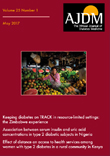Type 2 Diabetes patients and their Glucagonostatic potency (GLP-1)
*Corresponding Author:
Received: 09-Jul-2021 Accepted Date: Jul 23, 2021 ; Published: 30-Jul-2021
Hyperglucagonemia is very well-known contributor to diabetic hyperglycemia, and glucagon-like peptide one (GLP1) suppresses glucagon secretion. Reduced restrictive effects of the glucose and GLP-1 on glucagon secretion might contribute to the hyperglucagonemia in Diabetes disease and influence the success of GLP-1 receptor agonist therapy. we tend to examined the doseresponse relationship for GLP-1 on glucose-induced glucagon suppression in healthy people and patients with type two and kind 1 diabetes. In randomised order, ten healthy individuals with traditional glucose tolerance, 10 patients with type 2 diabetes, and 9 C-peptide negative patients with type 1 diabetes underwent 4 separate stepwise glucose clamps throughout coincidental blood vessel infusions of saline or 0.2, 0.4, or 0.8 pmol GLP-1/kg/min. In healthy people and patients with kind two diabetes, GLP-1 potentiated the hormone-suppressive impact of intravenous glucose in an exceedingly dose-dependent manner. In patients with type 1 diabetes, no vital changes in glucagon secretion were discovered during the clamps whether or not with saline or GLP-1 infusions. In conclusion, the glucagonostatic efficiency of GLP-1 during a stepwise glucose clamp is preserved in patients with type 2 diabetes, whereas our patients with type 1 diabetes were insensitive to the glucagonostatic effects of each aldohexose and GLP-1.
Inappropriate secretion of the glucagon, relative to the prevailing glycemia, contributes considerably to thehyperglycemia of type one and kind a pair of diabetes . The gut-derived incretin internal secretion glucagonlike peptide 1 (GLP-1) suppresses glucagon secretion additionally to its glucose-dependent insulinotropic impact. This glucagonsuppressive effect happens at plasma glucose levels at or higher than fast levels and contributes to the glucose-lowering effect of GLP-1. In healthy individuals, exogenous GLP-1 will increase glucose clearance and reduces heppatic or internal organ glucose output . The individual contributions of GLP-1’s glucagonostatic and insulinotropic effects to its glucoselowering effect are difficult to disentangle. In a pancreatic clamp study within which GLP-1–induced changes in circulating glucagon and hormone concentrations were mimicked one by one and together, GLP-1’s glucagonostatic and insulinotropic impacts were found to contribute regarding equally to the glucose-lowering effect of GLP-1 in patients with sort a pair of polygenic disorder . Importantly, the glucagonostatic effect of exogenous GLP-1 is believed to translate into lowering of plasma glucose severally of GLP-1’s insulinotropic effect, as incontestible in patients with type one diabetes. during addition, the GLP-1 receptor antagonist exending (9-39) NH2 has been shown to extend circulating glucagon and glucose levels in patients with sort one polygenic disorder and no residual b-cell perform These studies support a direct or a minimum of an hormone independent suppressive impact of GLP-1 on hormone secretion. Studies by Kjems et al. established reduced efficiency of GLP-1’s insulinotropic effect as a crucial pathophysiological characteristic of type a pair of diabetes, however the potency of GLP-1’s glucagono static effect in patients with type 1 diabetes and in patients with type 2 diabetes has not been completely investigated. we tend to speculated that reduced potency of GLP-1 to inhibit glucagon secretion whereas already (inadequately) suppressed by glucose may make a case for a part of the inappropriate secretion of hormone typically determined in patients with sort a pair of still as type one diabetes.





